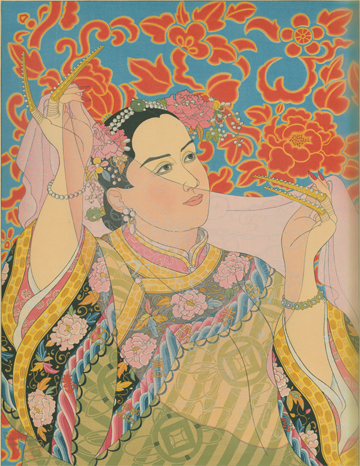
Paul Jacoulet, The Pearls, Mandchouko, n. d., 20th c, Ink on paper, 15 7/16 in. x 11 13/16 in., Gift of Mrs. Louise Padelford, Scripps College
Paul Jacoulet was born in Paris, France in 1902 and, in the years after moving to Japan when he was four, became well-versed in Japanese art forms. Later, pursuing a career as an artist, he began depicting subjects from Asia in his Ukiyo-e style prints. Jacoulet catered to a largely Western audience who embraced his bright color palette and romantic depiction of Asian subjects. In contrast to Japanese printmakers, Jacoulet illustrates the Western interpretation of Eastern life and his style greatly deviates from Japanese tradition. The Pearls, Mandchoukuo exemplifies this fantastical interpretation of the East. Mandchoukuo refers to the area that is now known as Mongolia. In this image, the female figure is placed outside of this identity and space. She floats in front of a patterned background that removes her from reality. The subject’s eyes are cast passively upward as she holds a veil over her face. Many Western artists of this period, including Jacoulet, took on the role of an anthropological transcriber, documenting cultures that they perceived as facing extinction. Jacoulet’s prints are aesthetically and technically advanced, but it is essential to consider the orientalist undertones of a supposedly “compassionate” depiction.[1]
[1] Richard Miles, The Prints of Paul Jacoulet (London: Robert G. Sawers Publishing: 1982)
Jocelyn Lo, Getty Collections/Conservation Summer Intern, 2015

